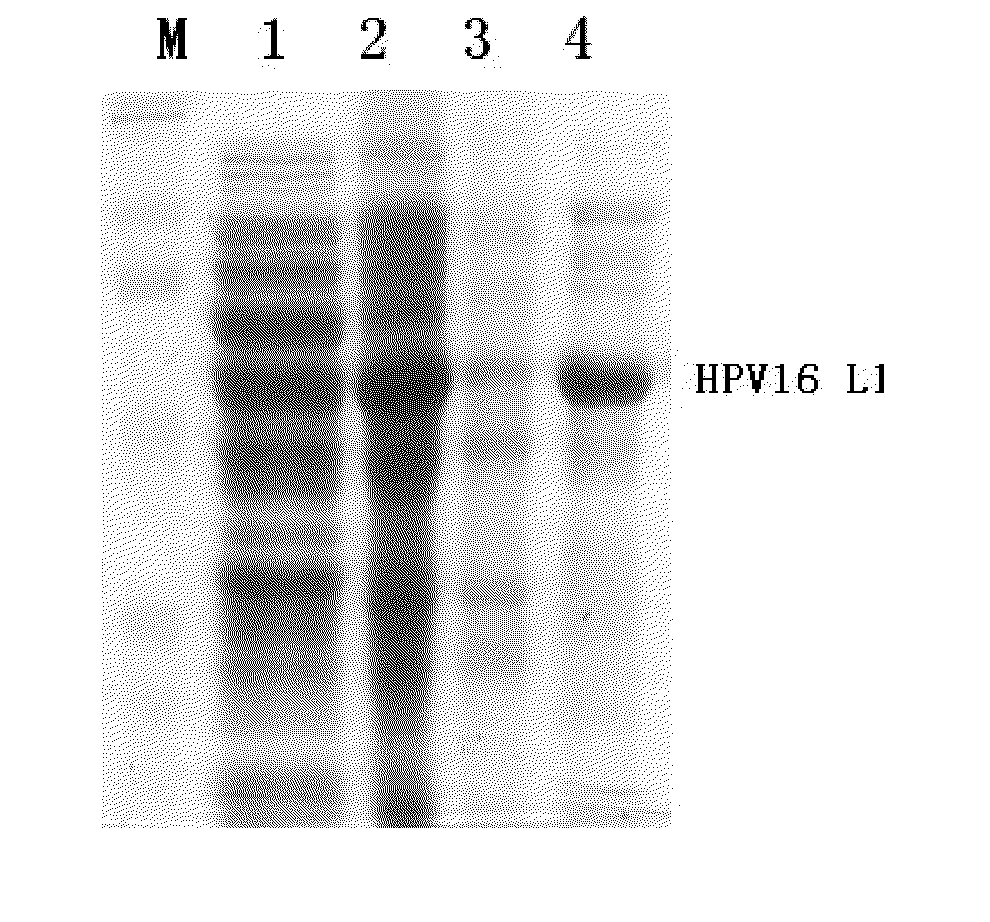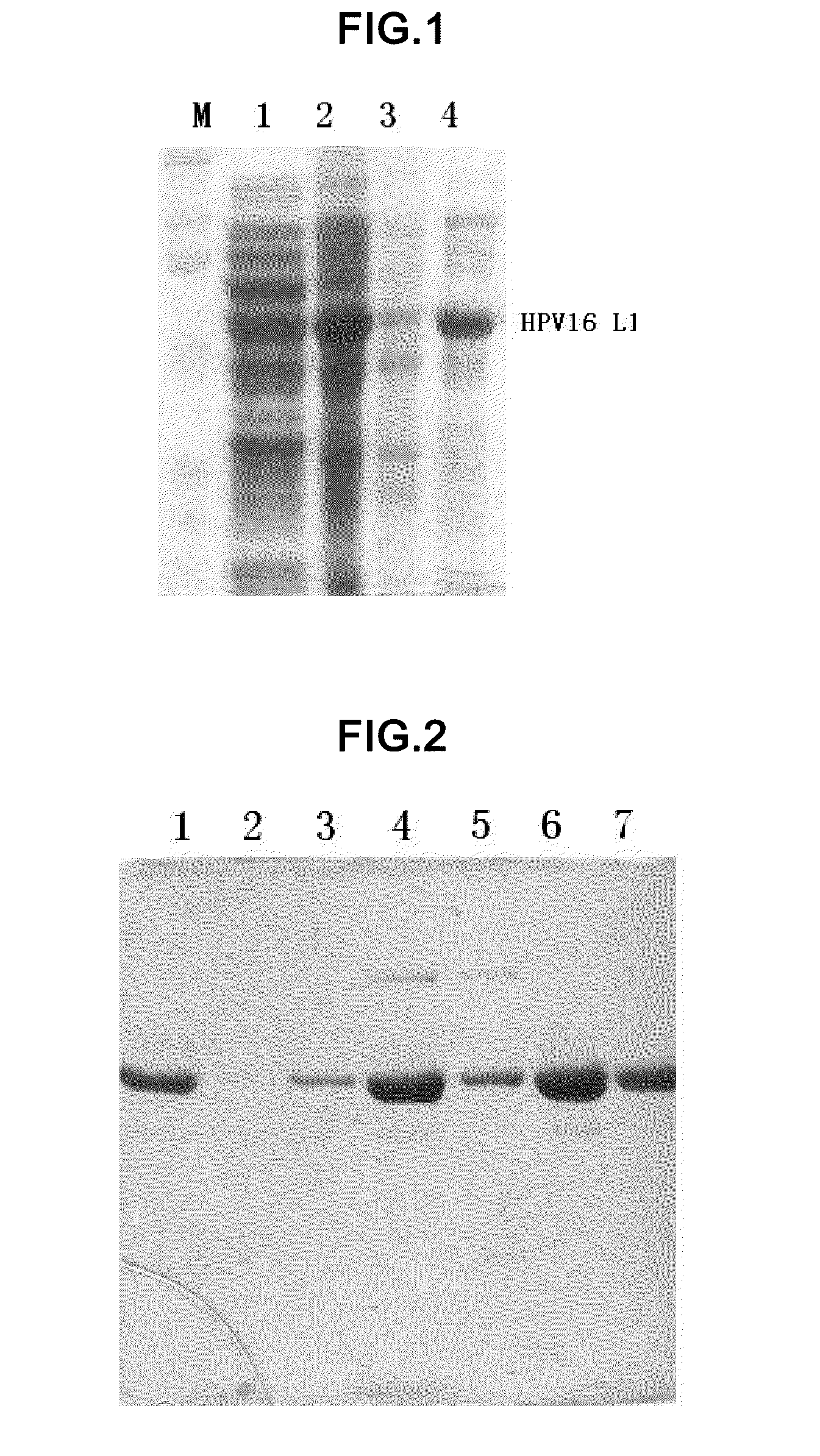Truncated l1 protein of human papillomavirus type 16
a human papillomavirus and l1 protein technology, applied in the field of truncated l1 protein of human papillomavirus type 16, can solve the problems of difficult industrial production on a large-scale, serious threat to the health of women, and high cost of hpv vaccine gardasil®, which came into the market recently, and achieves low expression levels, high cost, and high expression level
- Summary
- Abstract
- Description
- Claims
- Application Information
AI Technical Summary
Benefits of technology
Problems solved by technology
Method used
Image
Examples
example 1
Expression of the Truncated HPV16 μl Protein (SEQ ID NO.6)
[0074]Preparation of HPV16 μl Gene Fragments as PCR Template
[0075]DNA extracted from the vaginal secretion of cervical cancer patients from Xiamen City in Fujian province was used as a template. Forward primers were 16H5521F: 5′-TAT AGT TCC AGG GTC TCC AC-3′ (SEQ ID NO:12) and reverse primers were 16H7190R: 5′-ACA ACA AAC AAC ACT AAT TCA A-3′ (SEQ ID NO:13). PCR reaction was performed in a Biometra T3 PCR thermocycler using the following parameters:
94° C. denaturation 5 min94° C. denaturation 50 sec57° C. annealing 50 sec {close oversize brace} 25 cycles72° C. elongation 2 min72° C. elongation 10 min
[0076]The specific amplification product, about 1.6 kb in length, was used as the template to produce DNA fragments of the truncated HPV16 μl protein in the invention.
[0077]Construction of Non-Fusion Expression Vector of Truncated HPV16 L1 Gene
[0078]DNA fragments (1.6 kb) produced in the previous step were used as the template for...
example 2
Preparation HPV16N30C-L1 with a Purity of about 70%
[0097]1 g strains were re-suspended in 10 ml lysis buffer (20 mM tris buffer pH 7.2, 300 mM NaCl). Strains were disrupted by passing through a APV homogenizer (Invensys Group) for five times at a pressure of 600 bar. The homogenate was centrifuged at 30,000 g (13,500 rpm in JA-14 rotor) for 15 min. The supernatant was subjected to SDS-PAGE on a 10% gel. At this stage, the HPV16N30C-L1 had a purity of about 10%. The supernatant was dialyzed by a Centrasette 5 Tangential Flow Filter (Pall Co.) running at a pressure of 0.5 psi, a flow rate of 500 ml / min, and a tangential flow rate of 200 mL / min, wherein the retention molecular weight was 30 kDa, the dialysate was 10 mM phosphate buffer pH 6.0, and the dialysis volume was three times as large as the volume of supernatant. After thorough dialysis, the mixture was centrifuged at 12,000 g (9500 rpm in JA-10 rotor (Beckman J25 high speed centrifuge)) for 20 min, and the precipitation was co...
example 3
Chromatography Purification of HPV16N30C-L1
[0098]Cation Exchange Chromatography of HPV16N30C-L1
[0099]Equipment: AKTA Explorer 100 preparative liquid chromatography system (GE Healthcare, i.e. the original Amershan Pharmacia Co.)
[0100]Chromatographic media: SP Sepharose 4 Fast Flow
[0101]Column Volume: 5.5 cm×20 cm
[0102]Buffer: 20 mM phosphate buffer pH 7.5, 10 mM DTT
[0103]20 mM phosphate buffer pH 7.5, 10 mM DTT, 2M NaCl
[0104]Flow Rate: 25 mL / min
[0105]Detector Wavelength: 280 nm
[0106]Sample: the supernatant in 10 mM phosphate buffer pH7.5, 10 mM DTT, 300 mM NaCl in Example 2
[0107]Elution protocol: eluting undesired proteins with 400 mM NaCl, eluting the protein of interest with 500 mM NaCl, collecting 500 mM NaCl elutate, and finally getting about 1000 mL purified HPV16-L1 sample.
[0108]Purification of HPV16N30C-L1 by MC (Hydrophobic Interaction Chromatography)
[0109]Equipment: AKTA Explorer 100 preparative liquid chromatography system (GE Healthcare, i.e. the original Amershan Pharmac...
PUM
| Property | Measurement | Unit |
|---|---|---|
| diameter | aaaaa | aaaaa |
| molecular weight | aaaaa | aaaaa |
| particle size | aaaaa | aaaaa |
Abstract
Description
Claims
Application Information
 Login to View More
Login to View More - R&D
- Intellectual Property
- Life Sciences
- Materials
- Tech Scout
- Unparalleled Data Quality
- Higher Quality Content
- 60% Fewer Hallucinations
Browse by: Latest US Patents, China's latest patents, Technical Efficacy Thesaurus, Application Domain, Technology Topic, Popular Technical Reports.
© 2025 PatSnap. All rights reserved.Legal|Privacy policy|Modern Slavery Act Transparency Statement|Sitemap|About US| Contact US: help@patsnap.com



